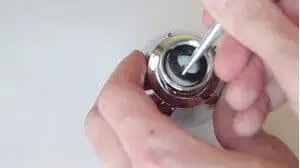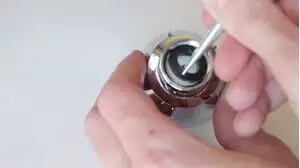 Installing a flow or water restrictor is intended to control the water flow in your shower head to less than 3 gallons per minute.Some regulators stipulate their use to help reduce water wastage in the shower.While the flow restrictor helps reduce flow to save energy and water, there may be challenges.
Installing a flow or water restrictor is intended to control the water flow in your shower head to less than 3 gallons per minute.Some regulators stipulate their use to help reduce water wastage in the shower.While the flow restrictor helps reduce flow to save energy and water, there may be challenges.
If the water pressure in your area is generally slow, a flow restrictor will slow down your flow even greater. Hence, you may need to take it out.Bear in mind that when you remove the flow restrictor, your water use may increase and escalate your monthly bill.
How do I locate the restrictor?
Check behind the metal piece in the shower head. It has a circular, flat, star-shaped design. The restrictor is the plastic part that covers the shower head inlet.They may come in colors and have slim, open inserts close to the edges.
Here are your tools:
Adjustable wrenches ,Paper clip,Towel or cloth,Plumber’s tape,Needle-nose pliers and Screwdrivers
Disconnect the shower arm from the tap
- Use a wrench and detach the shower head from the arm.
- Protect the parts from scratches or damage with a cloth, towel or masking tape.
- Wrap the cloth around the parts and turn until it comes loose.
- Look for the connection from the arm that’s attached to the wall.
- Unfasten the ball joint inside the shower head with a wrench.
- Remove the shower head from the arm.
Troubleshoot:
Apart from the flow restrictor, there are other areas than you need to check.If hot water runs through your shower head, examine the water heater for any issues that may also restrict water flow.
Sediment can build up in the water heating.
Make a full flush of the hot water system to remove any buildup.
Studies suggest you may install a water softener to help reduce sediment or replace the anode rod regularly.
Remove the gasket and screen:
Turn the shower head over and take out the gasket. The screen is attached to the inlet of the handle or shower head.
- Straighten the end of a paper clip and poke it around the gasket or O-ring inside the shower head.
- If it doesn’t come loose, try to pry it out with a screwdriver.
- Remove the gasket and protect it from any damage.If it is damaged, replace it with a new one.
- Examine the shower head and take out the screen if there’s one.
- Give the shower head a few knocks to dislodge the screen. If it stays in place, take it out with pliers.
How to clean the screen:
Take the screen; place it under the tap and let the water run on it. The water will help clear away any dust or sediment.
- Position the paper clip under a part of the restrictor.
- Twirl it and lift it up to take out the flow restrictor.
- You can also use a screwdriver or pliers to help pry it out.
Put the shower head back together:
- Put the gasket inside the shower head and slip it back into position.
- Re-install the shower screen inside the shower head.
- Unwind the plumber’s tape from the threads around the shower arm.
- Apply some fresh tape around the shower arm threads.
- Use a wrench to fasten the head connector onto the shower arm.
What if my restrictor is in the handheld shower?
To remove the restrictor from the handheld fixture:
- Check the instructor’s manual to help locate the restrictor.
- Look inside the part that connects shower arm or at the edge of the handle which attaches the flexible tubing.
How to remove the restrictor
First, unfasten the restrictor.
If the restrictor is at the edge of the handle:Wrap the connections with a cloth. Take hold of the nut with pliers. Turn it to the left to unfasten and take out the handle form the tubing.
Take out the washer
- Uncover the restrictor.
- Next, use the pliers and take out the washer within the handle and the filter screen.
- Remove the restrictor with a screwdriver.
- Now that the restrictor removed from the handheld shower, it’s a good idea to keep it working well.
How to help improve water flow in the handheld shower
Apart from replacing the water restrictor, you can help maintain the water flow in your shower head.It’s a good idea to make regular maintenance checks on our handheld shower.A regular maintenance schedule will lend support to the restrictor.
The process:
- Reduce buildup in the handheld shower.
- Keep the rubber tips on the shower head clean.
- Minimize water spots around the handheld shower.
1.Treating buildup in the handheld shower
- Detach handheld shower head from the connecting hose.
- Let the fixture rest in a vinegar and water solution for a few hours or overnight.
- Rinse away any sediment and dry it with a cloth or towel.
2. Treating the rubber sprays
Brush away any sediments around the hand held shower with a soft cloth or by hand.
3. Treating water spots
Rinse the handheld shower head with warm water.Dry it and reinstall it.
What if my restrictor is inside the holder?
Tools:
- Pliers
- Pipe wrench
Process
- Wrap a towel or rag around the connections and the shower arm.
- Use a pipe wrench to grip the shower arm and the pliers on the nut.
- Turn the nut to the left until the holder comes loose from the arm.
- Use the pliers to take out the washer and filter screen from the end of the holder.
-
Detach the restrictor with a screwdriver.
Re-connect the parts:
- Put the filter screen back into the washer.
- Secure it in place with a twirl of the finger.
- Peel away any worn plumber’s tape from around the threads.
- Apply some fresh tape to the shower arm, twisting it to the right.
- Fasten the connector to the threads by hand.
- Place a cloth over the nut and tighten it with a wrench.
You can also watch the below video for more information
Conclusion:
A water flow restrictor is used to help reduce water wastage by controlling the amount of water in the tap.Removing the restrictor may increase water flow, as well as energy usage and costs.Follow all instructions. Locate the restrictor and check other areas that might affect water flow. Remove it, reassemble all parts and allow your flow to increase.
